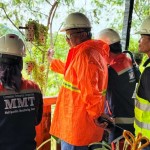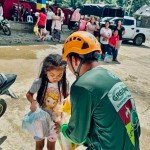Cleansing ritual highlights firm's unity with, respect for, IP hosts
This year, the Subanons of Siocon, Zamboanga del Norte under the leadership of Timuay Jose “Boy” Anoy performed the boklug as a cleansing rite and act of atonement for what the IP justices have ruled was the desecration of Mount Canatuan by recent human activities in the area. In Subanon tradition, the use of revered land by human activity is permitted provided a ritual is performed.
The Boklug ritual also served to remind everyone, especially those within the Certificate of Ancestral Domain Title (CADT) area, of the harmonious relationship formed by the Subanons and TVI Resource Development Philippines, Inc. (TVIRD). It was an act calling on religious spirits to honor the partnership.
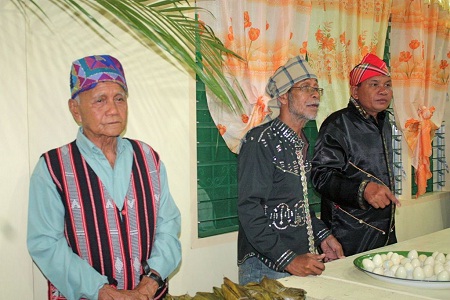
|
Above, from left, Gulang Gukom Noval Lambo, Timuay Jose “Boy” Anoy, and Timuay Fernando Mudai opened the Boklug with a prayer and passing of an incense around the people seven times to represent the Seven Rivers of Zamboanga Peninsula. Below, hosts and guests celebrate on the Boklug platform as another man climbs to join in.
|
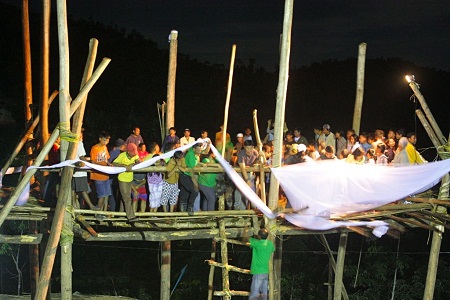
TVIRD was requested by the Subanons through their Pigbogolalan (governing body) to share the ritual with the company’s IP hosts. TVIRD has been operating a copper-zinc mine in Canatuan since mid-2004 by virtue of a Mineral Production Sharing Agreement with the Philippine government. From the early ‘90s to early 2000, thousands of illegal small-scale miners operated in the area.
“Pasalamat mi sa ila (TVIRD) nga ilang gituman among kasabutan nga ila ning (boklug) buhatun. Dako pud kog pasalamat nga gi-recognize nila among kultura. Pasalamat kong ilang girespeto nila among korte sa Subanon. Maayo among relasyon, maong mutabang pud mi. [We are grateful that they (TVIRD) honored the agreement to conduct this boklug, a recognition of our Subanon culture. We are pleased that they (the company) also recognized our Subanon courts. We have a good relationship with them (TVIRD personnel) and, in return, we also extend our help to them],” Timuay Anoy said.
The Gukom sog Pito Kodolungan (The Justices of the Seven Rivers), composed of the seven Timuays and their Gulang Gukom, the chief elder, were present during the opening of Boklug.
“The people and the Gulang Gukom of the Seven Rivers extend their heartfelt thanks to TVI(RD) for recognizing, respecting and complying with whatever was imposed on them by the Gukom,” Timuay Noval Lambo said during the opening day of Boklug in Canatuan. “As the Gulang Gukom of the Seven Rivers, I salute TVI(RD) for complying with all those things.”
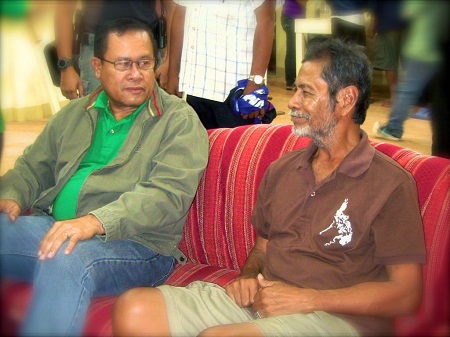
|
TVIRD Canatuan General Manager Ely Valmores (left) shares a light moment with Timuay Anoy on the first day of Boklug.
|
“We take pride in the growing strength of our partnership with our gracious Subanon hosts,” Ely Valmores, TVIRD Canatuan General Manager, said. “One of our biggest achievements in Canatuan is our gaining of the overwhelming support of Subanons — under the guidance of Timuay Anoy — who have joined us in the common effort of judiciously utilizing resources as a means of attaining economic and social progress.”
TVIRD officials and personnel who joined the Boklug participated in the most important and longest portion of the ritual, which was held in the Subanon Training Center, the hub of the celebration within Canatuan. At the start of Boklug, a prayer was said and incense was passed around the participants seven times, representing the seven rivers. This was followed by the padugo or bloodletting, where a pig was sacrificed and its blood allowed to flow on the ground to symbolize cleansing.
Later on, men, women and children skipped, hopped and gyrated to the sound of the kulintang and gagong that were continuously pounded by the indigenous percussion ensemble, mostly elderly members of the tribe. Other hosts and guests helped themselves with the overflowing food. Pangasi, the native fermented rice wine, was omnipresent. Only one or two straws were used to sip the beverage from jars, which were passed around for everybody to share. Subanons from within the CADT and from all over the Zamboanga Peninsula joined and enjoyed in the revelry.
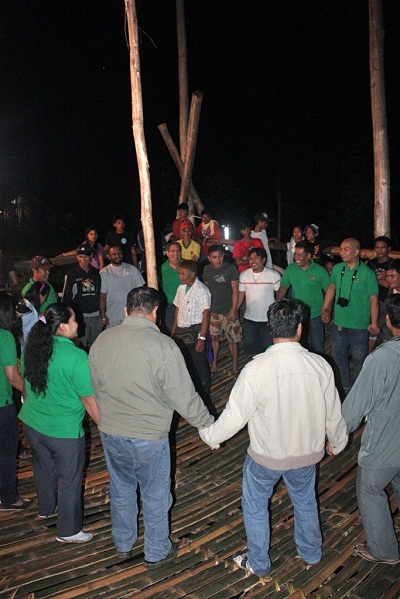
|
Above, TVIRD officials, staff and personnel gather in a circle as they prepare to dance, jump and move in unison to make the stage move downward, which, in turn, results in the pole pounding the hollow log underneath the platform. Below, Subanon adults and children do the same movement to create the unique reverberating sound that can be heard from great distances.
|
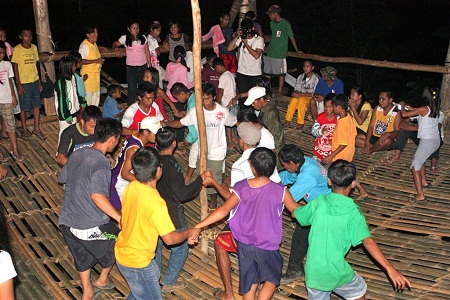
The preparations for the Boklug started months before the agreed date, which, as tradition required, should fall on a full moon. The preparations entailed, among other things, looking for sturdy bayog and tubungon trees to be used as foundations and pillars, as well as for bamboo as ceremonial platform. The four strong, heavy pillars stood 25 feet high, erected with the skills and strength of Subanon men. With the foundation and pillars in place, the workers placed bamboo strips to form the platform – the boklug. The platform was built strong to be able to bear the weight of dancers and participants, and pliable enough to allow the movement of everybody on stage without breaking. In the middle of the platform, a 6-inch diameter by 12-meter long pole made from the bayog tree was inserted vertically and positioned perpendicular to a 3-meter hollow log, which was, in turn, placed horizontally on the ground beneath the structure.
Boklug is performed during a full moon to represent “a full decision”. It also serves a practical purpose because of the natural light. Hosts and visitors of all ages take turns to go up the platform to dance. A traditional dance step is followed to ensure movement in unison. They jump and dance together, accompanied by joyful shouts from the dancers. The synchronized downward movement makes the pole strike the hollow log underneath, creating the unique resonating sound that echoes throughout the ancestral land. The sound indicated that the ritual was ongoing.
The costumes of Subanons – usually in white, black or red – who came have interesting meanings. White represents the servant of Apo Magibak-Sanag, a god in all-white garb and with glowing hair who oversees his people. Black costumes are mostly for community leaders or Timuays who see black as a practical color for moving around places so that accumulated dirt will not be noticeable. Red costumes are for the warriors of the tribe: brave, strong, and unwavering. Some say it represents blood.
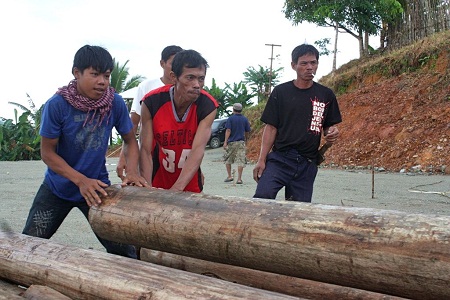
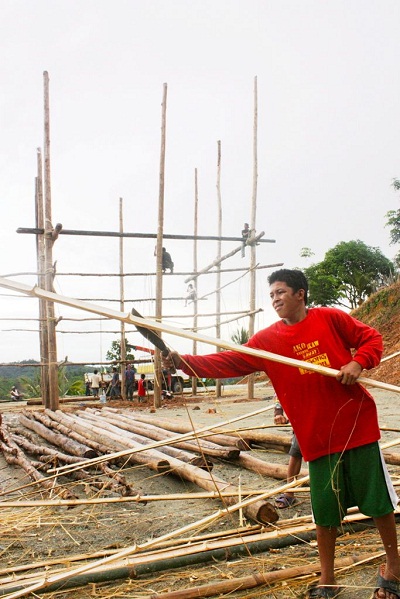
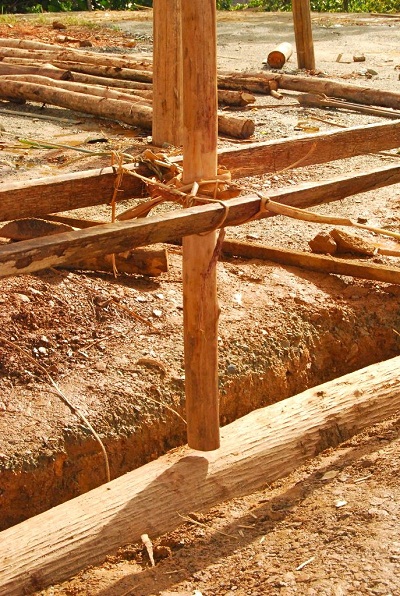
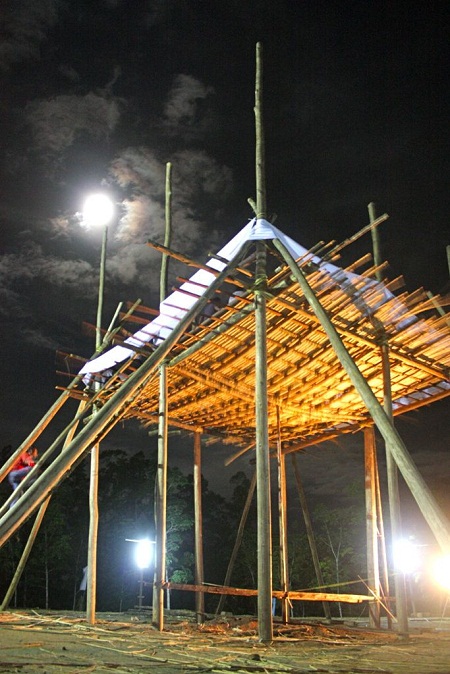
|
Top photo shows Subanon men working with their bare hands to construct the Boklug platform. Second from top photo: a man smoothens a bamboo strip to be used as flooring for the platform. Second from bottom photo: a 6-inch diameter by 12-meter long pole made from the bayog tree was inserted vertically and positioned perpendicular to a 3-meter hollow log, which was, in turn, placed horizontally on the ground beneath the structure.Bottom photo: Boklug is performed during a full moon to represent “a full decision”. It also serves a practical purpose because of the natural light.
|
According to Timuay Fernando Mudai, the name Canatuan was derived from the Subanon word Cotuan or kutluanan, which means the source from where something is gathered, plucked or picked. In olden times, he said, people believed that in Cotuan, people are “plucked” and died as a result. They believed that something strange things happened because people died mysteriously. The tale was that if a person passes by Cotuan or would go to Cotuan, he will die without any explanation at all. Hence, Cotuan had the reputation of being a no man’s land.
However, as time passed by, Cotuan, which subsequently became “Canatuan”, changed its reputation for the better. It became synonymous with being a source of tambal or medicine. Legend has it that a servant of Apo Magibak-Sanag was born in Canatuan. He is Timuay Manglang of Siocon, born to mortal parents but had some powers that ordinary mortals did not have. He introduced a new belief or faith called palin.
Apo Magibak-Sanag befriended the people who used to murder the people who passed by Canatuan. He was able to sow peace in the land by forging a peace pact between the mortals and the immortals on top of Mount Canatuan. Since then, the people were able to gather medicines for the sick. At the side of the mountain is a place for rituals called Solongsonan. People performed rites there to ask permission from the gods to pass by Canatuan, to enter the forest or to cut trees. After the rituals, people were free to do what they want because they have asked permission as a sign of respect.
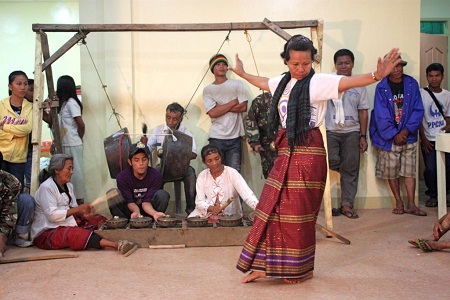
|
As part of the celebration, the elderly women play the kulintang while men strike the gagong to produce rhythmic sounds. At foreground is Annabelle Combi, the Siocon Subanon Women’s Association Inc. (SSWAI) president, performing her tribe’s traditional dance.
|
Timuay Mudai also spoke of the dreaded disease in area: leprosy. The legend says one of those afflicted was Apo Matampas, the son of Timuay Manglang. He was brought to Canatuan where he stayed in a hut made of bark of trees. He was left with rice and water. After a year, his provisions were almost consumed. With the little strength left in his body, he bit the bark of trees that made up his hut. Little by little, he regained his strength returned and he got well. From then on, people with diseases went to Canatuan to gather, pick or pluck medicines for their sickness.
“The Canatuan of today remains to be a source,” Mudai pointed out. “This time, the source of livelihood and prosperity not only for the Subanons but also for other people.
“What is past is past. TVIRD and the Subanon people are united, helping and supporting one another. We shall gather all the good things for development not only for one group but for everybody. We must cleanse our hearts of any ill feelings. We must welcome development…for progress,” Timuay Mudai said.
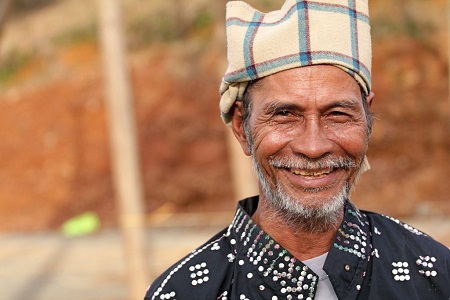
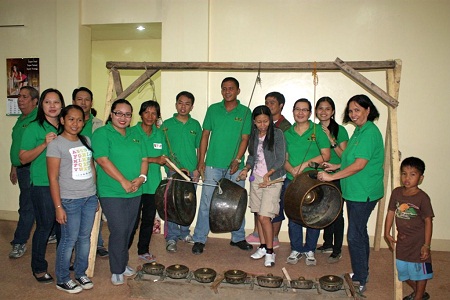
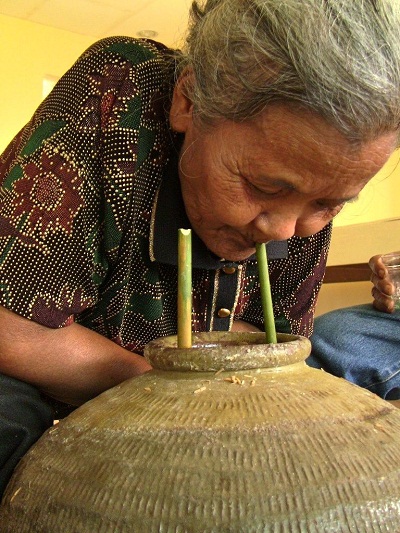
|
In top photo, Siocon Timuoy Jose “Boy” Anoy flashes a smile after expressing his gratitude to TVIRD for fulfilling his tribe’s request for a joint conduct of the Boklug. Middle photo shows TVIRD officials and personnel posing for posterity at the Subanon Training Center, the hub of the Boklug celebration. Bottom: pangasi, the native fermented rice wine, was omnipresent. Only one or two straws were used to sip the beverage from jars, which were passed around for everybody to share.
|
Before TVIRD operated in Canatuan in July 2004, the company removed and reprocessed over a 13-month period nearly 24,000 tonnes of mercury and cyanide contaminated tails produced by previous illegal small-scale mining operations in the area. Since TVIRD’s well-regulated mining operations began, the Subanons in Canatuan and other residents in neighboring communities have been benefitting from the company’s socio-economic development activities in the areas of education, livelihood and employment, health and sanitation, and infrastructure. Timuay Anoy has acknowledged that these basic services have greatly improved the lives of members of his tribe. (Rihanna Angeles)

